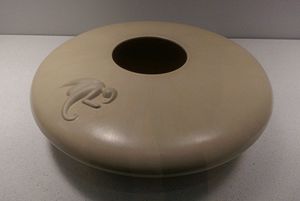Al Qöyawayma facts for kids
Quick facts for kids
Al Qöyawayma
|
|
|---|---|
| Born | February 26, 1938 Los Angeles, California, U.S.
|
| Nationality | American |
| Occupation | Potter and sculptor |
Alfred H. Qöyawayma is a talented Hopi artist. He is known for making beautiful pottery and sculptures out of bronze. Born in Los Angeles on February 26, 1938, he also has a background as a mechanical engineer. He even helped create guidance systems for machines! Plus, he co-founded the American Indian Science and Engineering Society, which supports Native Americans in science and engineering.
Contents
Early Life and Education
Al Qöyawayma grew up in the San Fernando Valley. He was the only child of Mayme and Alfred. He went to Van Nuys High School. In 1961, he graduated from California Polytechnic State University in San Luis Obispo, California. He later earned a master's degree in engineering from the University of Southern California. His aunt, Polingaysi Qöyawayma, was a famous educator and potter.
Artistic Career

Al Qöyawayma's art mixes different cultures and has a simple, clean style. Many of his pots feature maize (corn). Corn is very important in Hopi religion. It represents food, ceremonies, prayers, and life itself. The Hopi people believe corn becomes part of them, like a mother's milk.
Qöyawayma finds and prepares his own clay. He uses a special spiral coiling method to shape his pots. He fires them at a very high temperature. This makes the clay smooth and shiny. He uses coal for heating, a method used by his Coyote clan of the Hopi for a long time.
He learned traditional Hopi pottery and stories from his aunt, Elizabeth Q. White. She wrote a book in 1964 called No Turning Back: A Hopi Woman's Struggle to Live in Two Worlds. In her book, she advised people to value their own culture. She also encouraged them to learn from other cultures and not limit themselves.
Pottery expert Lee M. Cohen has said that Al Qöyawayma's pottery is unique. He believes Al's deep respect for his Hopi ancestors makes his work so special.
Pottery in Space
In 2002, astronaut John Herrington took one of Qöyawayma's ceramic pots into space. Herrington is a member of the Chickasaw tribe. The pot traveled aboard Space Shuttle mission STS-113. This mission docked with the International Space Station. The pot was a tiny "Sikyatki-style seed jar with a corn design." It is now part of the collection at the National Museum of the American Indian.
Sharing Pottery Skills
Qöyawayma received a special grant called a Fulbright fellowship. He used it to help the Maori of New Zealand. He helped them bring back their tradition of making ceramic pottery. He has also advised the Smithsonian Institution about ancient Sikyátki ceramics.
Exhibitions
Al Qöyawayma's artwork has been shown in many places. Here are some of the exhibitions:
- Night of the First Americans, Kennedy Center, Washington, DC, 1982
- First Showing of Contemporary American Indian Art, National Museum of Natural History, Washington, DC, 1982–83
- Al Qoyawayma: A Retrospective, Taylor Museum at the Colorado Springs Fine Arts Center, Colorado Springs, 1985
- Head, Heart and Hands: Native American Craft Traditions in a Contemporary World, American Craft Museum, New York, 1999
- The Road to Aztlan Austin Museum of Art, Austin, Texas, 2001
- Jewels of the Southwest, Museum of Indian Arts and Culture, Santa Fe, 2002
- Changing Hands New Mexico Museum of Art, Santa Fe, 2003
- Inaugural Opening, National Museum of the American Indian, Washington, DC, "Space Pot", 2004
- HOME: Native People of the Southwest, Heard Museum, 2005
- Gift of the Gods: Exploring Maize, Culture and Indigenous Art in the Americas, Hearst Gallery, St. Mary's College of California, Moraga, California, 2011

